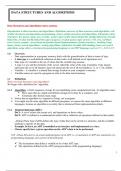Class notes
data structures
- Course
- Institution
Introduction to data structures and algorithms: definitions and uses of data structures and algorithms, role of data structures and algorithms programming, choice of data structures and algorithms. Elementary data structures: list, queue, stack, tree, records, arrays; types of list: linear-linked ...
[Show more]



